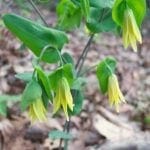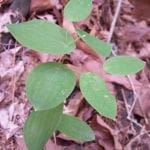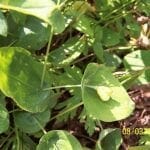- Flowers
- Foliage
- Seed pod
- Flowers
Scientific Name:
Uvularia perfoliata
Common Name:
Bellwort
Scientific Name Pronounciation:
oo-voo-LAR-ee-a per-foh-lee-AY-tuh
Plant Type:
Perennial
Plant Hardiness Zones:
4-9
Plant Hardiness Zone(s):
Usual Size:
6-12 in. H x 12 in. W
Flower:
1-1.5-inch long, 6-petaled bell-shaped hanging yellow flower; inside of flower orange and rough
Bloom Time Notes:
Late Spring
Leaf:
Leaves alternate, smooth, blue-green in color, lance-shaped with stem piercing the base of the 2-5 inch leaf.
Fruit:
3-cornered, 1-inch capsule; green in summer, ripe early fall; up to 3 flattened round seeds in each of the 3 chambers.
Wildlife:
Pollinated by bees.
Natural Habitat:
Found in a variety of wet woods; hardwood slopes, bluffs and coves.
Propagation:
Seed; division of offsets in early spring or fall.
Bloom Time:
Sun or Shade:
Companion Plants:
Cultural Notes:
Merrybells (Uvularia perfoliata) grows in sun to part shade; average to organic soil; moderate to moist conditions; acid soils. Most likely to be confused with Uvularia grandiflora which has hairy leaves underneath and larger flowers, up to 2 inches long.
According to the "doctrine of signatures" it was thought that the blossoms look like the uvula, or palate (that pink appendage which hangs down the back of the throat). " Wort " is a name formerly given to plants used for food or medicine. When used as a suffix, it often just means " plant." The scientific name comes from " the flower hanging like the uvula."
Other Common Names: Wood Merrybells





